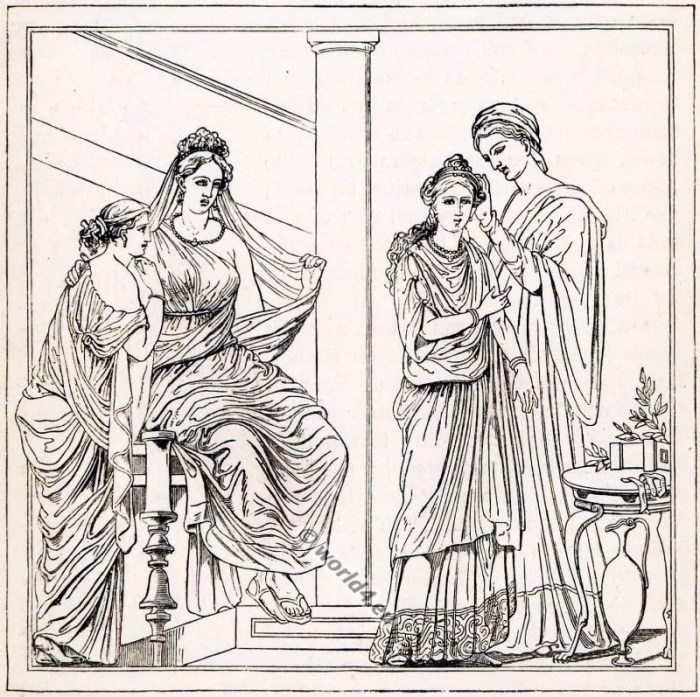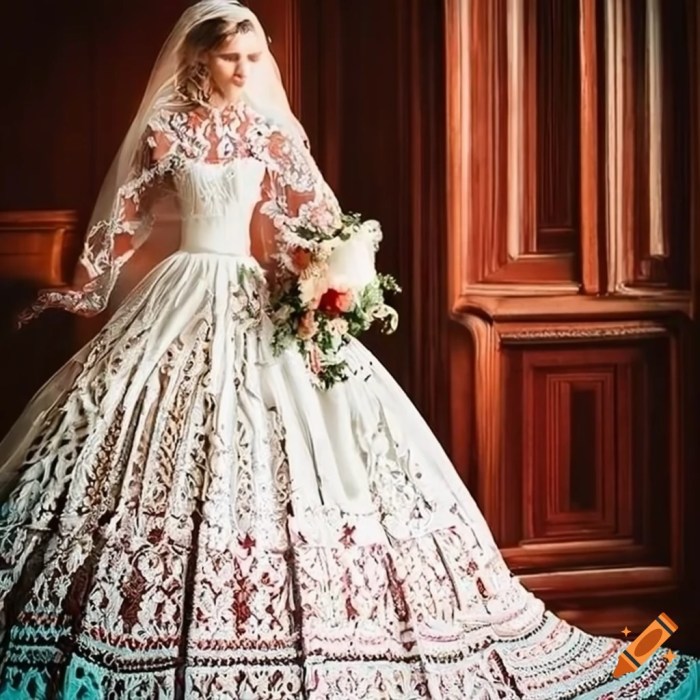The Evolution of Gypsy Wedding Dress Styles: Outrageous Gypsy Wedding Dresses
Outrageous gypsy wedding dresses – Gypsy wedding attire has undergone a fascinating evolution, reflecting both the nomadic lifestyle and the rich cultural heritage of the Romani people. Influences from various regions and historical periods have shaped the distinctive styles seen today. This evolution is marked by changes in fabrics, embellishments, and overall design aesthetics.
Historical Influences on Gypsy Wedding Attire
Historically, Gypsy wedding dresses drew inspiration from the readily available materials and the prevalent fashions of the regions where Romani communities settled. Early styles often featured simpler designs, reflecting practicality for a nomadic life. However, even in simpler designs, vibrant colors and intricate hand-stitching were common. The influence of local cultures is clearly visible in the variations found across different Gypsy communities.
Transformation of Traditional Designs Over Time
Over time, Gypsy wedding dresses became increasingly elaborate. The incorporation of luxurious fabrics like velvet, silk, and brocade reflected a growing prosperity in some communities. Intricate embroidery, beading, and other embellishments became hallmarks of the style, showcasing the skill and artistry of the dressmakers. The evolution also reflects changing social contexts and the adoption of broader fashion trends.
Comparison of Modern and Historical Styles
While modern Gypsy wedding dresses retain many traditional elements, they also incorporate contemporary design influences. Historical styles often featured more modest silhouettes and simpler embellishments compared to the extravagant designs popular today. The use of bold colors and opulent fabrics remains consistent, though modern interpretations might incorporate more diverse materials and silhouettes.
Evolving Design Elements
The following table showcases the evolution of key design elements in Gypsy wedding dresses:
| Era | Fabrics | Embellishments | Silhouette |
|---|---|---|---|
| Early 20th Century | Cotton, Linen, Wool | Simple embroidery, hand-stitching | A-line, modest |
| Mid-20th Century | Velvet, Silk | Beading, sequins, lace | More fitted bodice, fuller skirt |
| Late 20th Century | Brocade, satin | Intricate embroidery, heavy beading | Varied silhouettes, including empire waist |
| 21st Century | Variety of fabrics, including modern synthetics | Extensive beading, sequins, crystals, feathers | Wide range of silhouettes, often dramatic and voluminous |
Key Design Elements in Outrageous Gypsy Wedding Dresses
The term “outrageous” in the context of Gypsy wedding dresses refers to the dramatic and extravagant nature of the designs. These dresses are characterized by their bold use of color, texture, and embellishments, aiming for a visually stunning effect. The focus is on creating a memorable and impressive ensemble for the bride.
Defining Characteristics of “Outrageous” Gypsy Wedding Dresses
Outrageous Gypsy wedding dresses are defined by their lavish use of embellishments, vibrant colors, and unique design choices. They often push the boundaries of traditional wedding attire, resulting in eye-catching and memorable looks. The dresses are typically voluminous, with layers of fabric and elaborate detailing. The overall aesthetic is one of opulence and extravagance.
Use of Color, Pattern, and Texture
Bold and vibrant colors are a key feature, often incorporating multiple hues within a single garment. Intricate patterns, ranging from floral motifs to geometric designs, are frequently used, adding to the visual richness. A variety of textures, from the sheen of silk to the sparkle of sequins, contribute to the overall sensory experience.
Role of Embellishments in Creating a Dramatic Effect
Embellishments play a crucial role in achieving the dramatic effect. Layers of beading, embroidery, sequins, and other decorative elements are meticulously applied, creating a dazzling display. These embellishments are often concentrated on key areas like the neckline, sleeves, and skirt, drawing attention to specific design features.
Unconventional Materials Used in Outrageous Dresses
Beyond traditional fabrics, unconventional materials might be incorporated to enhance the visual impact. These additions can significantly contribute to the overall “outrageous” aesthetic.
- Feathers
- Rhinestones
- Crystals
- Metallic threads
- Faux fur
The Cultural Significance of Gypsy Wedding Attire
Gypsy wedding dresses hold deep cultural significance, representing more than just bridal attire. Specific design elements often carry symbolic meaning, reflecting traditions and beliefs passed down through generations. Understanding this symbolism provides insight into the rich cultural heritage of the Romani people.
Symbolism and Traditions Associated with Gypsy Wedding Dresses
The vibrant colors often symbolize joy, celebration, and good fortune. Intricate embroidery might depict traditional patterns or stories, conveying family history and cultural identity. The amount of embellishment can sometimes reflect the bride’s family’s wealth and status. The overall design communicates the bride’s place within her community and family.
Cultural Significance of Specific Design Elements

Source: world4.eu
For example, certain floral patterns might symbolize fertility or prosperity, while specific colors might be associated with particular deities or beliefs. The choice of fabrics can also hold significance, reflecting both availability and cultural preferences. These details showcase the deep connection between the dress and Romani cultural traditions.
Comparison to Wedding Attire in Other Cultures
Compared to wedding attire in other cultures, Gypsy wedding dresses stand out for their extravagance and emphasis on vibrant colors and elaborate embellishments. While many cultures value symbolic elements in their wedding attire, the level of ornamentation and the focus on visual spectacle is often unique to Romani traditions.
Visual Representation of a Dress Showcasing Key Cultural Symbols
Imagine a dress in a deep crimson velvet, symbolizing passion and good fortune. The bodice is intricately embroidered with a swirling floral pattern, representing fertility and abundance. Gold sequins are densely scattered across the skirt, symbolizing wealth and prosperity. The sleeves are adorned with cascading layers of lace, representing the bride’s lineage and family history. The overall effect is one of opulent beauty and cultural richness.
Modern Interpretations and Trends
Contemporary designers are increasingly reinterpreting traditional Gypsy wedding dress styles, blending traditional elements with modern fashion trends. This fusion results in unique and contemporary designs that honor the heritage while reflecting current aesthetics. The influence of runway trends and popular culture is evident in these modern interpretations.
Contemporary Designers Reinterpreting Traditional Styles
Many contemporary designers are drawing inspiration from traditional Gypsy wedding dress elements, incorporating them into their collections. These designers often adapt traditional designs to suit modern tastes, while still maintaining the essence of the original style. This demonstrates the enduring appeal and adaptability of Gypsy wedding dress aesthetics.
Incorporation of Modern Fashion Trends
Modern interpretations often incorporate current fashion trends, such as specific silhouettes, fabrics, and embellishment techniques. This blending of traditional and modern elements results in designs that are both unique and relevant to contemporary tastes. The integration of modern elements ensures that the style remains fresh and dynamic.
Comparison of Traditional and Modern Interpretations of Outrageous Elements
While modern interpretations maintain the spirit of extravagance, they may differ in their execution. Traditional “outrageous” elements, such as extensive beading, might be reimagined with more streamlined techniques or the use of different materials. The overall effect remains dramatic, but the approach might be more refined or contemporary.
Modern Trends in Gypsy Wedding Dress Designs
Several modern trends are influencing the design of Gypsy wedding dresses:
- A-line and mermaid silhouettes
- Use of lace and tulle
- Incorporation of metallic fabrics
- Statement sleeves
- Asymmetrical designs
The Impact of Media on Perceptions of Gypsy Wedding Dresses
Media portrayals, particularly television shows and documentaries, have significantly shaped public perception of Gypsy wedding dresses. These portrayals, both positive and negative, have influenced trends and interpretations of the style. It’s crucial to consider the impact of these representations on public understanding.
Media Portrayals and Their Influence on Public Perception
Television shows, such as “My Big Fat Gypsy Wedding,” have brought Gypsy wedding dresses into the mainstream consciousness. These shows, however, often focus on the most extravagant aspects, potentially creating a skewed perception of the style. This can lead to a misunderstanding of the cultural significance and the diversity of Romani traditions.
Influence of Media on Trends and Interpretations
Media representations have undoubtedly influenced trends and interpretations of Gypsy wedding dresses. The focus on elaborate designs and abundant embellishments has popularized a particular aesthetic, impacting both the designs created and the public’s expectations. This highlights the powerful role of media in shaping fashion trends.
Examples of Media Representations and Their Impact
Documentaries offering a more nuanced perspective on Romani culture can counteract the potentially stereotypical representations found in reality television. By showcasing the diversity of traditions and the craftsmanship involved, these documentaries can contribute to a more informed and respectful understanding of Gypsy wedding attire.
Comparison of Positive and Negative Media Portrayals
While some media portrayals focus on the extravagance and spectacle of Gypsy wedding dresses, others highlight the cultural significance and the artistry involved in their creation. Positive portrayals emphasize the beauty and tradition, while negative portrayals may perpetuate stereotypes or focus solely on the extreme aspects of the style. A balanced approach is needed to present a comprehensive and accurate understanding.
The Craftsmanship and Creation Process
The creation of an elaborate Gypsy wedding dress is a labor of love, requiring extensive skill and dedication. The intricate craftsmanship involved highlights the artistry and tradition behind these unique garments. Understanding the process provides appreciation for the time and effort invested in each piece.
Intricate Craftsmanship Involved in Creating Elaborate Dresses

Source: craiyon.com
The creation process involves a multitude of intricate techniques, including beading, embroidery, and the careful layering of fabrics. These techniques require significant skill and patience, often passed down through generations of dressmakers. The level of detail and precision is remarkable, resulting in truly breathtaking garments.
Techniques Used in Embellishing and Constructing Garments, Outrageous gypsy wedding dresses
Various techniques are employed to create the intricate embellishments. Beading can involve attaching thousands of individual beads, requiring meticulous handwork. Embroidery might incorporate complex patterns and stitches, demanding both skill and artistic vision. The construction of the garment itself involves careful tailoring and draping to create the desired silhouette.
Time and Effort Required to Produce a Single Dress
Creating a single Gypsy wedding dress can take months, even years, depending on the complexity of the design and the amount of embellishment. The time commitment reflects the dedication and artistry involved in producing these unique pieces. The process is often a collaborative effort, involving multiple skilled artisans.
Step-by-Step Description of Creating a Specific Design Element
Consider the process of beading a neckline. First, a pattern is created to guide the placement of the beads. Then, individual beads are carefully sewn onto the fabric, ensuring even spacing and secure attachment. Different beading techniques can be employed, such as couching or seed beading, depending on the desired effect. Finally, the beaded neckline is carefully attached to the dress, ensuring a smooth and seamless finish.
Expert Answers
How much do outrageous Gypsy wedding dresses typically cost?
Dude, that’s a HUGE range! It depends on the designer, the materials, and the level of embellishment. Think anywhere from a few thousand to, like, tens of thousands of dollars for some seriously custom creations.
Where can I find outrageous Gypsy wedding dresses?
You can find some seriously unique pieces from independent designers online or at bridal boutiques specializing in alternative wedding styles. Etsy is also a great place to start looking for one-of-a-kind designs!
Are there any ethical considerations when buying a Gypsy wedding dress?
For sure! It’s important to be mindful of cultural appropriation and to support designers who respect and celebrate Romani culture rather than exploiting it for profit. Look for designers who work directly with Romani artisans or who donate a portion of their profits to Romani charities.
